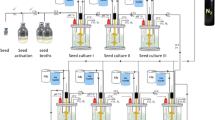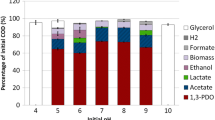Abstract
The effects of acetate and butyrate during glycerol fermentation to 1,3-propanediol at pH 7.0 by Clostridium butyricum CNCM 1211 were studied. At pH 7.0, the calculated quantities of undissociated acetic and butyric acids were insufficient to inhibit bacterial growth. The initial addition of acetate or butyrate at concentrations of 2.5 to 15 gL−1 had distinct effects on the metabolism and growth of Clostridium butyricum. Acetate increased the biomass and butyrate production, reducing the lag time and 1,3-propanediol production. In contrast, the addition of butyrate induced an increase in 1,3-propanediol production (yield: 0.75 mol/mol glycerol, versus 0.68 mol/mol in the butyrate-free culture), and reduced the biomass and butyrate production. It was calculated that reduction of butyrate production could provide sufficient NADH to increase 1,3-propanediol production. The effects of acetate and butyrate highlight the metabolic flexibility of Cl. butyricum CNCM 1211 during glycerol fermentation.
Similar content being viewed by others
Author information
Authors and Affiliations
Additional information
Received: 2 January 2001 / Accepted: 6 February 2001
Rights and permissions
About this article
Cite this article
Colin, T., Bories, A., Lavigne, C. et al. Effects of Acetate and Butyrate During Glycerol Fermentation by Clostridium butyricum . Curr Microbiol 43, 238–243 (2001). https://doi.org/10.1007/s002840010294
Issue Date:
DOI: https://doi.org/10.1007/s002840010294




